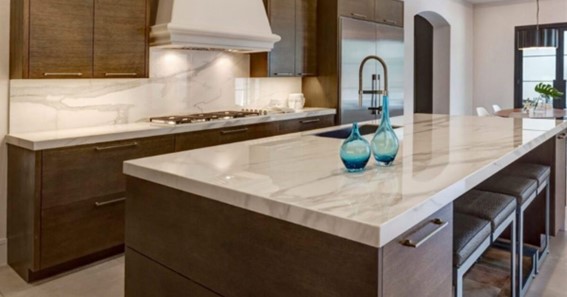Are you curious to know what is sintered stone? You have come to the right place as I am going to tell you everything about sintered stone in a very simple explanation. Without further discussion let’s begin to know what is sintered stone?
In the realm of architectural surfaces, sintered stone has emerged as a revolutionary material, pushing the boundaries of design and functionality. With its exceptional durability, versatility, and eco-friendliness, sintered stone has become a preferred choice for architects, designers, and homeowners alike. In this blog, we embark on a journey to explore what sintered stone is, its manufacturing process, key features, and its transformative impact on the world of design and construction.
What Is Sintered Stone?
Sintered stone is a man-made material composed of natural minerals, clay, feldspar, silica, and other raw materials. The process of sintering involves applying high pressure and temperature to these raw materials, fusing them together to form a dense and ultra-durable slab. This innovative manufacturing process mimics the geological processes that create natural stone, resulting in a product that boasts the best characteristics of various materials.
The Manufacturing Process
The production of sintered stone starts with the careful selection and blending of natural raw materials. These materials are then compacted under extreme pressure, reaching up to 15,000 pounds per square inch. The next stage involves subjecting the compacted materials to temperatures exceeding 2,100 degrees Fahrenheit (1200 degrees Celsius). This high-temperature process causes the particles to fuse, creating a non-porous and incredibly sturdy slab.
Key Features And Advantages
- Exceptional Durability: Sintered stone is highly resistant to scratches, stains, and UV rays. Its robust composition makes it suitable for high-traffic areas, both indoors and outdoors.
- Versatility in Design: Sintered stone comes in various sizes, thicknesses, and finishes, allowing for seamless integration into diverse design styles and applications.
- Heat and Fire Resistance: Unlike some natural stone materials, sintered stone can withstand high temperatures without warping or deforming, making it ideal for kitchen countertops and outdoor cooking areas.
- Low Porosity: The sintering process creates a non-porous surface, making sintered stone hygienic and easy to clean.
- Eco-Friendly: Sintered stone is made from natural raw materials and does not emit any harmful substances, contributing to a greener and more sustainable construction industry.
Transforming Design And Architecture
The introduction of sintered stone has revolutionized the world of design and architecture. Its versatility and adaptability have led to its use in a wide range of applications, including kitchen countertops, bathroom vanities, flooring, wall cladding, outdoor facades, and even furniture.
Designers and architects are drawn to sintered stone for its ability to mimic the appearance of natural materials like marble, granite, and wood while offering enhanced performance and durability. This opens up a world of creative possibilities, allowing designers to explore new concepts and push the boundaries of modern aesthetics.
Conclusion
Sintered stone has emerged as a game-changer in the world of architectural surfaces, combining the beauty of natural materials with exceptional durability and sustainability. As this innovative material continues to gain popularity, it is reshaping the landscape of design and construction, inspiring architects, designers, and homeowners to create spaces that are not only aesthetically pleasing but also highly functional and environmentally responsible. With its endless possibilities and remarkable performance, sintered stone stands as a testament to human ingenuity and our ongoing quest for innovative solutions in the realm of design and architecture.
Visit Longests to know about longest things in the world.
FAQ
What Is Sintered Stone Made From?
What is Sintered Stone? Like Quartz, Sintered Stone is a manufactured product made from a base of natural stone. Depending on the manufactuer, Quartz has a base of 88%-95% natural quartz stone, mixed with pigments, polymers and resins which is what bonds the slab together.
What Is The Downside Of Sintered Stone?
Con: The cost of sintered stone can be higher due to the fact that it’s a relatively new material. Con: “The biggest disadvantage is that the installation process isn’t DIY-friendly and should always be done by a professional,” says Micetich.
Is Sintered Stone Expensive?
Sintered stone is a durable option for countertops, walls, flooring, and more. It costs between $60 to $100 per square foot installed.
Is Sintered Stone More Expensive Than Granite?
One of the main disadvantages of sintered stone is its cost. While it may be more affordable than natural stone like granite or marble, it is still more expensive than materials like laminate or solid surface. This means that homeowners who are on a tight budget may need to consider other options.
I Have Covered All The Following Queries And Topics In The Above Article
What Is Sintered Stone
What Is Sintered Stone Made Of
What Is A Sintered Stone
What Is Sintered Stone?
Sintered Stone What Is It
What Is Sintered Stone Countertops
What Is Sintered Stone Table Top
What Is Sintered Stone Dining Table
What Is Neolith Sintered Stone?
What Is Sintered Stone Surface
What Is A Sintered Stone?
What Is Sintered Stone
Does sintered stone break easily
What is sintered stone?
